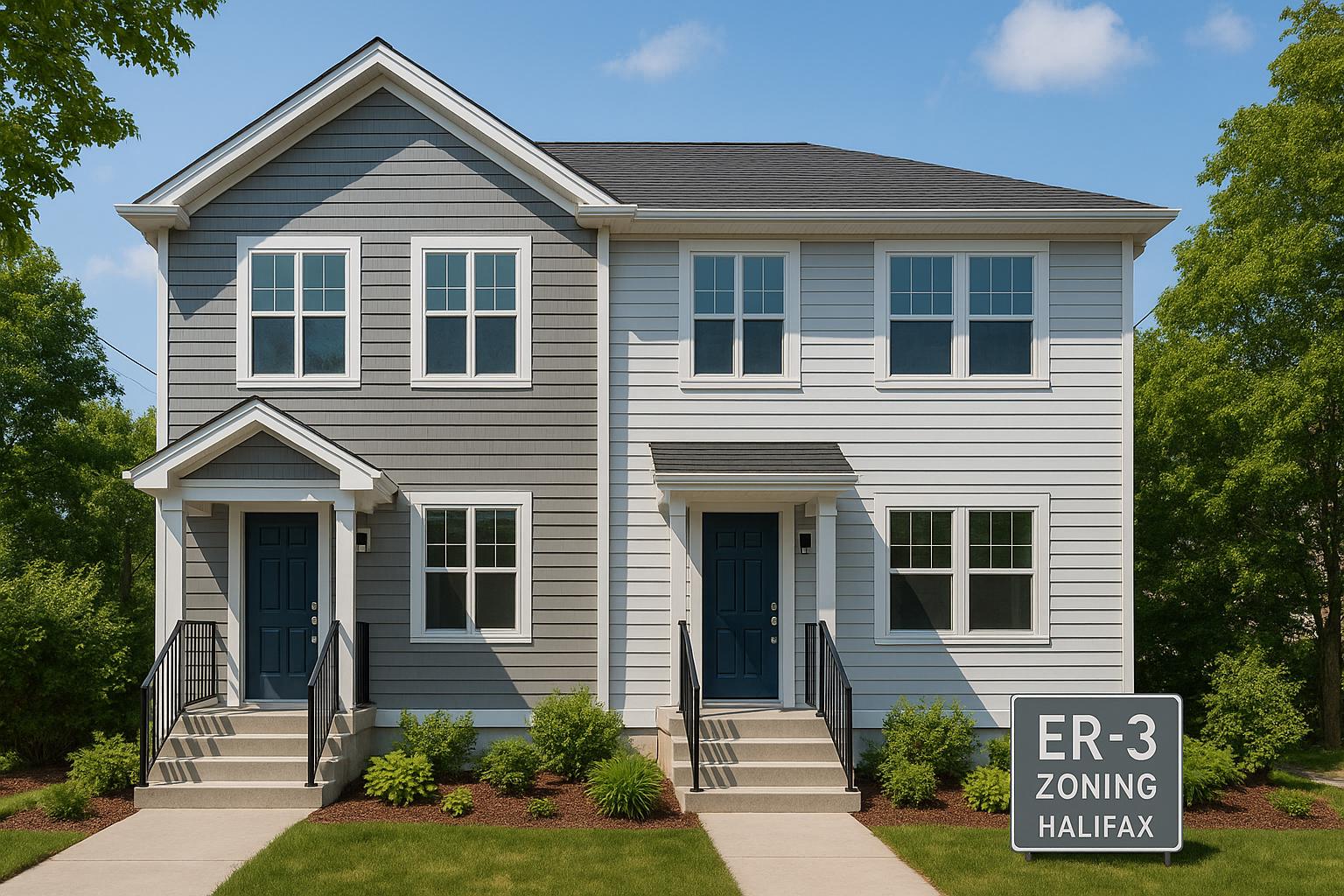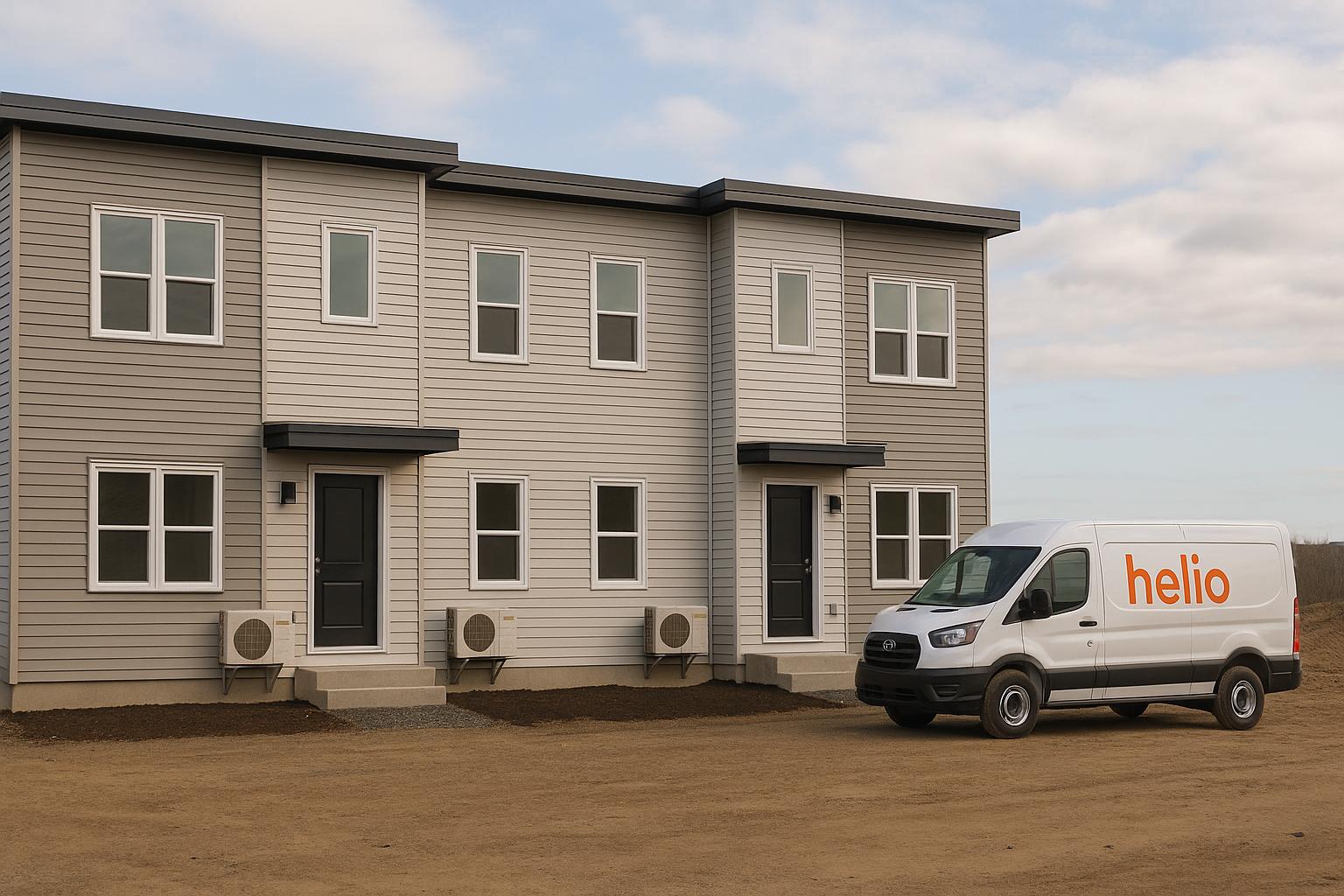Construction mortgages in Nova Scotia are designed to fund building projects in stages, ensuring financial control and progress accountability. Here's what you need to know:
- Draws: Funds are released incrementally as construction milestones are completed (e.g., foundation, framing, finishing). Payments are interest-only during the build phase.
- Holdbacks: Lenders retain 10% of each payment to protect against unpaid subcontractor liens. These are released 45 days after project completion, pending no liens.
- Lender Requirements: A strong credit score (680+), a 20–35% down payment, detailed construction plans, and proof of your builder's qualifications are essential.
Planning ahead, managing cash flow, and choosing experienced builders can help you avoid delays, budget overruns, and compliance issues. These steps also make securing financing smoother and keep your project on track.
How the Draw Process Works
How Draws Are Released
The draw process uses a step-by-step system where funds are provided only after independent inspections confirm that specific construction milestones are completed. For instance, once the foundation is finished, you can submit a draw request. An inspector will then verify that the work aligns with approved plans and building codes. This process usually takes a few business days, but weather issues or construction deficiencies can sometimes cause delays.
It’s important to note that the draw schedule is based on a formula and doesn’t directly reflect the actual costs incurred at each stage. As Richards Mortgage Group explains:
"The draw schedule is formula-driven and not directly related to the actual cost to reach a stage, meaning the borrower does not get a dollar-for-dollar match for money already invested." [1]
Draw Schedule Stages and Percentages
In Nova Scotia, most construction mortgages follow a five-stage draw schedule. Each stage is tied to a specific construction milestone. For example, in a project costing $640,000, the first draw - 15% of the total - would amount to $96,000. Since these disbursements are based on percentages rather than actual costs, property owners may need to cover some upfront expenses until the corresponding draw is released.
| Draw # | Percentage | Construction Milestone Required | Cumulative % |
|---|---|---|---|
| #1 | 15% | Excavation and foundation completed | 15% |
| #2 | 25% | Roof installed and the building is weather-protected with secured access | 40% |
| #3 | 25% | Plumbing and wiring initiated, drywall completed, furnace installed, cladding finished | 65% |
| #4 | 20% | Kitchen cupboards installed, bathrooms completed, doors hung | 85% |
| #5 | 15% | Final touches complete with the building ready for occupancy and passing final inspections | 100% |
The second draw is often the largest single release, while the final two draws focus on interior finishing and completing the project. These last payments are only disbursed after the building meets occupancy standards. This phased release system also aligns with your interest-only payment structure during construction.
Interest-Only Payments During Construction
As funds are released in stages, you’ll only pay interest on the amount already drawn, ensuring your payments match the construction’s progress. Typically, construction mortgages in Nova Scotia involve interest-only payments during the building phase, which lasts 12 to 18 months. For instance, if you’ve drawn $150,000 at an annual interest rate of 7.5%, your monthly interest payment would be about $937.50. As you draw more funds, your interest payments will increase accordingly.
Lenders usually set strict timelines for construction to manage risk. If your project significantly exceeds the agreed schedule, penalties may apply, or you might need to switch to a permanent mortgage before construction is finished. Normally, the transition to permanent financing happens within 30 to 60 days after the final inspection and issuance of an occupancy permit.
It’s crucial to manage your cash flow effectively to pay contractors while waiting for the next draw. Many property owners use a construction line of credit, maintain extra cash reserves beyond their down payment, or arrange interim financing with their builder. Preparing a detailed cash flow worksheet before starting construction can help you stay on track and ensure funds are available when needed.
Avoid These Costly Homebuying Mistakes in 2025 at All Costs!
Holdbacks and How They Protect Property Owners
While progress draws ensure that funding aligns with the pace of construction, holdbacks are designed to shield property owners from potential payment disputes.
What is a Holdback?
A holdback refers to the 10% of each payment retained as required by Nova Scotia's Builders' Lien Act. This mechanism ensures protection for property owners against liens filed by unpaid subcontractors or suppliers.
Here’s how it works: when you make payments to your contractor during the project, you’re legally obligated to withhold 10% of each payment until 45 days after the project reaches substantial completion. For example, if your contractor invoices $50,000 for completing the foundation, you would pay $45,000 and retain $5,000. Over the course of the project, these holdback amounts accumulate into a significant sum by the time construction wraps up.
Why is this necessary? Subcontractors and suppliers have the right to file liens against your property if they aren’t paid by the general contractor - even if you’ve already paid the contractor in full. The holdback serves as a financial cushion to resolve these disputes, ensuring your property ownership remains secure.
This safeguard is particularly important in complex, multi-unit projects where numerous trades are involved - electricians, plumbers, concrete suppliers, and more, all of whom could potentially file liens. The holdback system ensures there’s a fund to address any unpaid claims. Next, let’s look at how these funds are released once payment disputes are settled.
How to Release Holdback Funds
Releasing holdback funds involves following a strict 45-day statutory period, which begins once your project reaches substantial completion. Substantial completion generally means the building is ready for its intended use - like when you obtain an occupancy permit - even if minor work remains unfinished.
During this 45-day window, any subcontractor or supplier who hasn’t been paid must file a lien against your property. If they don’t, they lose the right to do so permanently. It’s important to note that you cannot release the holdback funds to your contractor until this period has ended, even if the contractor pressures you to wrap up the project quickly.
Before releasing the holdback, you should conduct a title search through the Nova Scotia Registry of Deeds to confirm there are no liens registered against your property. If any liens are found, they must be resolved - either by ensuring payment to the claimants or by having the liens discharged legally - before the funds can be released.
Once the 45-day period passes without any liens, you can release the holdback to your contractor. For added peace of mind, many property owners request a statutory declaration from the contractor, confirming that all subcontractors and suppliers have been fully paid. This step provides extra assurance and serves as valuable documentation for your records.
If you’re working with a lender, they’ll typically calculate the 10% holdback on the total project value and ensure these funds are available throughout the construction process. This coordination between mortgage draws and holdback requirements helps keep cash flow steady while ensuring compliance with legal obligations.
sbb-itb-16b8a48
Lender Requirements for Construction Mortgages
Getting a construction mortgage in Nova Scotia requires detailed preparation and solid financial credentials. Since construction projects are seen as higher-risk investments, lenders carefully evaluate applications, expecting borrowers to present a strong financial profile and extensive documentation. These measures ensure that only well-prepared applicants receive funding.
Credit Score and Financial Documents
Your credit score plays a major role in your construction mortgage application. Most Canadian lenders look for a credit score of at least 680, though scores of 700 or higher often come with better rates and terms [2]. If your score falls short, you can improve it by paying down debts, making consistent on-time payments, and reducing your credit utilization.
Financial stability is especially critical for construction loans, which often overlap with existing housing expenses. Lenders will closely examine your income, employment history, and current debts to confirm you can handle these dual obligations [2]. Expect to provide detailed records, including valid ID, proof of income (such as pay stubs, tax returns, and letters from your employer), and a comprehensive list of your assets and liabilities [3]. If you're self-employed, you'll also need business tax returns and financial statements. Additionally, lenders typically require a debt-to-income (DTI) ratio of 45% or less, along with proof of extra reserves to cover more than just your down payment and construction costs [3].
Down Payment Requirements
Construction mortgages generally require a larger down payment compared to traditional home loans, typically between 20% and 35% of the total project cost. For instance, if you're constructing a fourplex valued at $640,000, your down payment could range from $128,000 to $224,000. This calculation often includes the value of the land and construction expenses, meaning if you already own the land, that equity can count toward your down payment.
Lenders may also require you to show that you have additional funds available to manage unexpected costs, such as delays or budget overruns. Beyond financial reserves, the builder’s qualifications are another key factor in reducing lender concerns.
Builder Credentials and Experience Requirements
Lenders place significant importance on your builder’s qualifications since the contractor’s expertise directly impacts the project’s success and their financial risk. Your application should include thorough documentation of your builder’s credentials, including proof of a valid Nova Scotia construction licence, liability insurance, and workers’ compensation coverage [3].
For self-build projects, lenders often require evidence that you have relevant construction experience and project management skills. Past experience with similar projects, detailed project timelines, and subcontractor agreements may also be necessary [2].
Working with an integrated design-build company can simplify the process, as they provide a single point of accountability, reducing coordination challenges. This approach not only streamlines the construction process but also reassures lenders. Be prepared to submit site plans and proof that all necessary building permits and engineered drawings have been secured or will be obtained before construction begins [3].
Common Construction Mortgage Problems and Solutions
Even with thorough preparation, property owners in Nova Scotia can encounter challenges when securing construction financing or managing multi-unit projects. Below are some common hurdles and practical ways to address them.
Preventing Budget Overruns and Delays
Budget overruns are a frequent and expensive issue in construction. Traditional projects often see costs balloon by 30–60% beyond the initial estimate, especially with cost-plus contracts where unexpected price increases can catch you off guard. When your financing is tied to the original budget, these overruns may leave you scrambling for extra funds or bring your project to a standstill.
A smart way to avoid this is by opting for fixed-price construction contracts. These agreements lock in your total project cost before work begins, shielding you from unexpected price hikes in materials or labour. For example, if your fourplex project is budgeted at $640,000, a fixed-price contract ensures that figure won’t inflate due to market fluctuations.
Timeline delays are another costly problem. They not only extend your construction loan interest payments but also delay your rental income. Poor project coordination can stretch an 8-month timeline into 18 months or more. To counter this, advanced scheduling and systematic project management are key. Contractors who rely on structured planning instead of guesswork can often complete projects in as little as 6 months, compared to the industry standard of 12–18 months. Some builders even offer guaranteed completion dates, with financial penalties - up to $1,000 per day - if they miss deadlines, transferring the risk of delays from you to them.
While fixed-price contracts and better timelines are essential, keeping up with documentation and regulations is equally critical.
Meeting Regulatory and Lender Requirements
Incomplete documentation can derail your construction mortgage process. Missing paperwork often results in approval delays, which can jeopardize your project timeline.
To prevent this, create a detailed documentation checklist early on. Make sure your builder provides proof of licensing, insurance certificates, and references from recent projects. Additionally, confirm that all permits and architectural drawings are either secured or scheduled well in advance.
Regulatory compliance is particularly challenging for multi-unit projects, which must meet stricter building codes than single-family homes. In Nova Scotia, properties with 4 or more units are subject to specific rules regarding fire safety, accessibility, and energy efficiency. Failure to meet these standards during construction can halt progress and lead to costly adjustments.
Choosing builders who specialize in multi-unit projects can help you sidestep compliance issues. These professionals are well-versed in the regulations for fourplexes and larger buildings, ensuring your project meets all requirements from the design stage to final inspection.
Working with Integrated Design-Build Companies
Beyond managing budgets and timelines, integrated design-build companies can simplify the entire construction process. One common issue is fragmented project management, where multiple professionals - architects, engineers, contractors, and subcontractors - work independently. This lack of coordination can add an average of $47,000 in inefficiencies to a project.
Integrated design-build firms solve this problem by combining all key roles under one roof. Instead of juggling relationships with half a dozen contractors, you work with a single team that handles everything from design to construction. This approach eliminates communication gaps, ensures accountability, and reduces misunderstandings that could lead to delays or cost overruns.
These companies also improve quality control. By addressing potential issues during the design phase, they can avoid costly fixes later in the process. Many integrated firms also provide unified warranties covering both design and construction, offering added peace of mind.
For lenders, integrated design-build companies are appealing because they minimize risk. Their established track records, comprehensive insurance, and streamlined management processes make them reliable partners. Plus, their ability to complete projects faster means you can start generating rental income sooner, enhancing your overall return on investment.
Your Next Steps with Construction Mortgages
To navigate construction financing in Nova Scotia successfully, understanding the key elements - draws, holdbacks, and lender requirements - is crucial. These components work together to keep your project running smoothly from start to finish.
The draw system ensures that funds are released incrementally as construction progresses, while holdbacks act as a safeguard against potential liens or defects. Meeting lender requirements early - such as credit scores and builder qualifications - helps avoid delays that could disrupt your timeline or inflate your budget.
Choose an experienced builder who not only meets lender standards but also keeps detailed documentation of progress. Builders familiar with construction mortgages understand the draw process, submit inspection reports promptly, and maintain the quality standards lenders expect. This can make a significant difference in keeping your project on track.
Prepare your financial documentation early. This includes gathering financial statements, tax returns, and proof of income. Additionally, verify your builder’s licences, insurance, and references for similar multi-unit projects to prevent unnecessary delays.
Consider working with integrated design-build companies that are already familiar with lender expectations. These firms handle both design and construction, reducing coordination issues and increasing the likelihood of completing your project on time. This streamlined approach can help ensure a smooth transition from construction financing to a permanent mortgage.
A well-planned construction mortgage is the foundation of a successful multi-unit project. By understanding how draws, holdbacks, and lender requirements fit together, you'll be better positioned to complete your property efficiently and start generating rental income as planned.
FAQs
How can I ensure smooth cash flow during construction when the draw schedule doesn't align with expenses?
Managing cash flow during a construction project takes thoughtful planning, especially when your lender's draw schedule doesn’t align perfectly with your actual expenses. Construction loans are typically released in stages, known as draws, which are tied to completed work verified by an inspector. These funds are then sent to your lawyer, who handles payments to your builder.
To cover any gaps between the lender's draw schedule and your builder’s payment requirements, it’s wise to have a financial cushion in place - whether that’s extra savings or access to a line of credit. Alongside this, a well-thought-out budget that tracks your expected cash inflows and outflows can help you foresee and manage any shortfalls. By taking these steps, you can keep your project moving forward without unnecessary interruptions.
What should I do if a subcontractor places a lien on my property during the holdback period?
If a subcontractor files a lien against your property during the holdback period, Nova Scotia's Builders' Lien Act requires you to withhold 10% of all payments made to contractors. This holdback serves as a safeguard for property owners, ensuring there are funds available to settle any legitimate claims.
To address the lien, start by verifying the amount owed and checking that the holdback funds are enough to cover it. If the situation feels complex or unclear, it’s wise to consult a legal expert experienced in construction law. They can help you navigate the process and ensure you’re following local regulations properly.
How does working with an integrated design-build company make the construction mortgage process easier in Nova Scotia?
Working with an integrated design-build company can make the construction mortgage process much easier by offering a single point of accountability. Instead of juggling multiple contracts and contractors, you deal with just one team. This unified approach simplifies payment schedules and creates clarity, which can help lenders feel more confident about approving financing.
By combining design and construction under one roof, this method reduces the risk of miscommunication, delays, or budget surprises. It keeps everything aligned, making it less likely for unexpected changes to disrupt lender requirements or throw off your budget.



